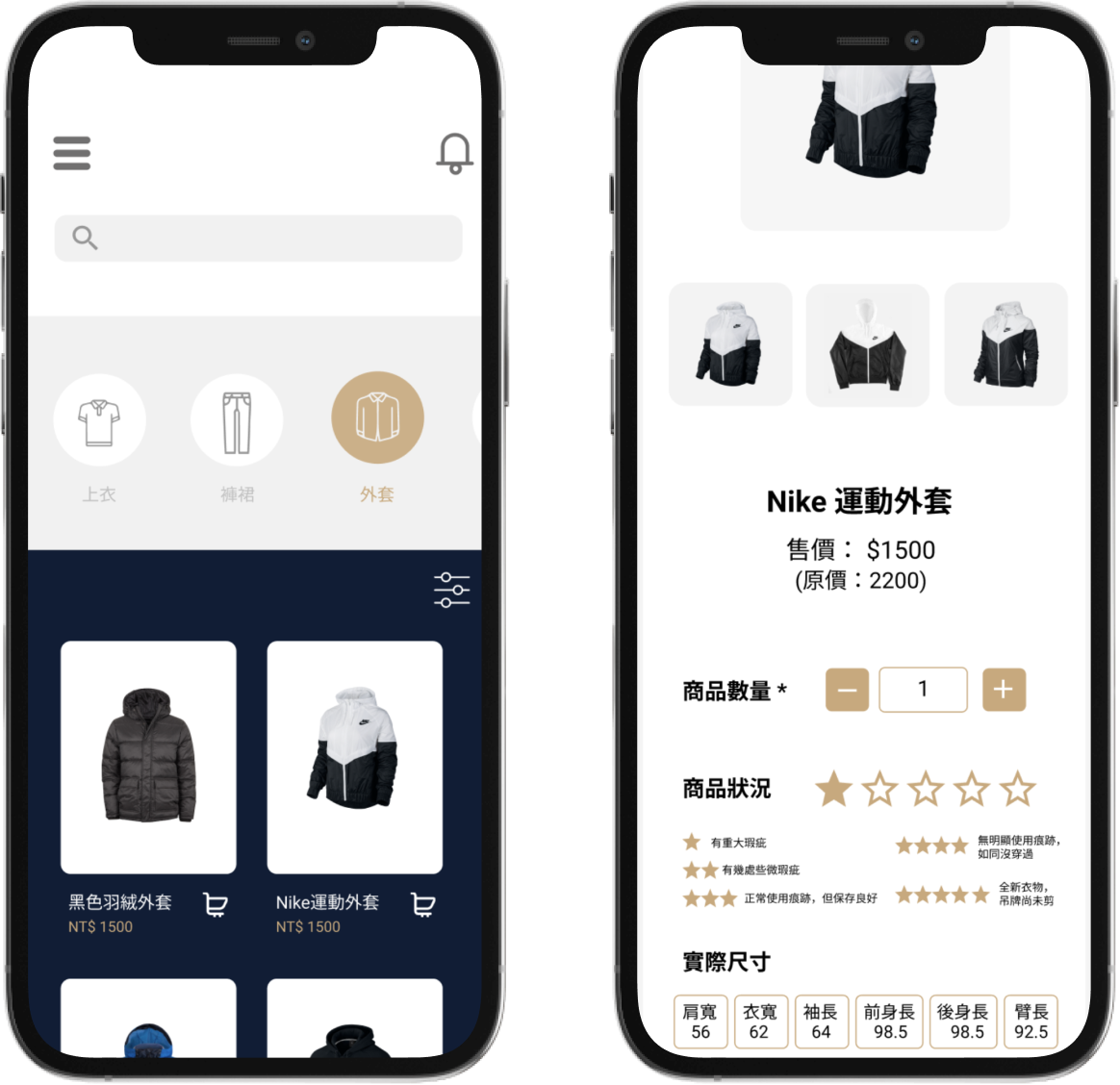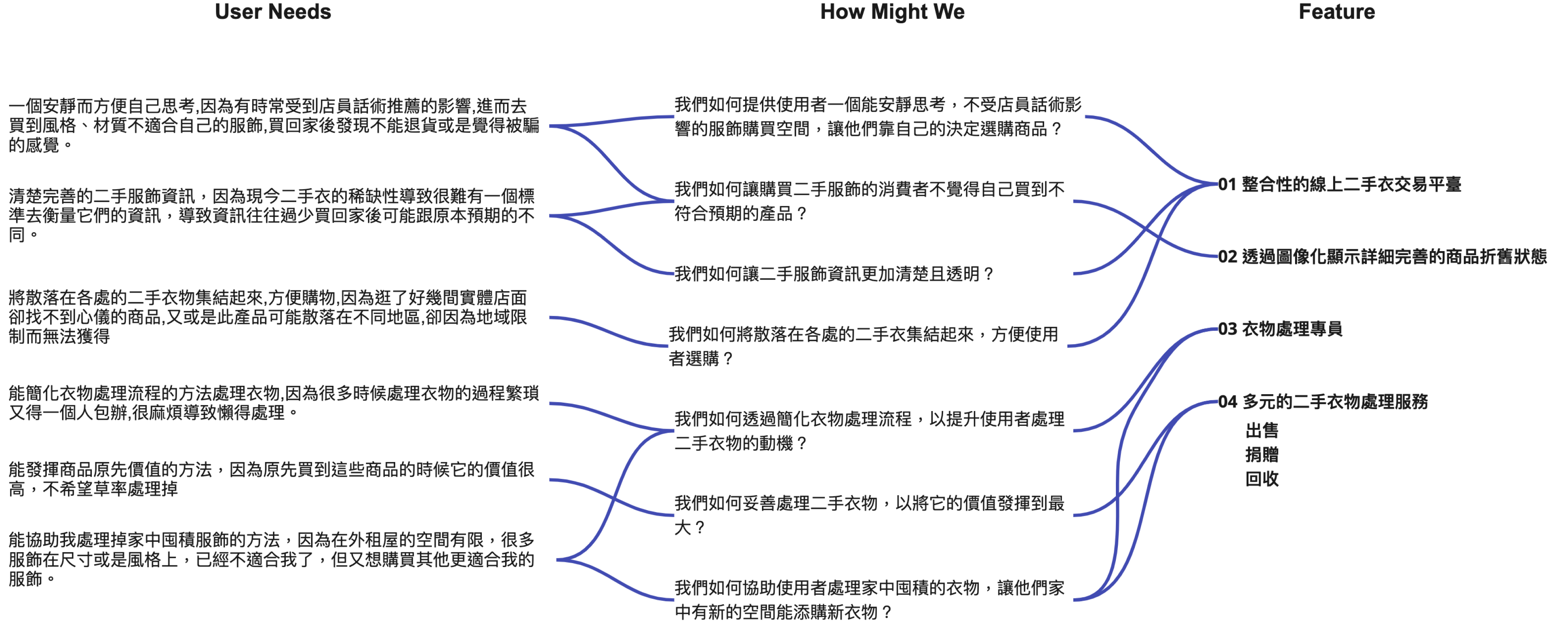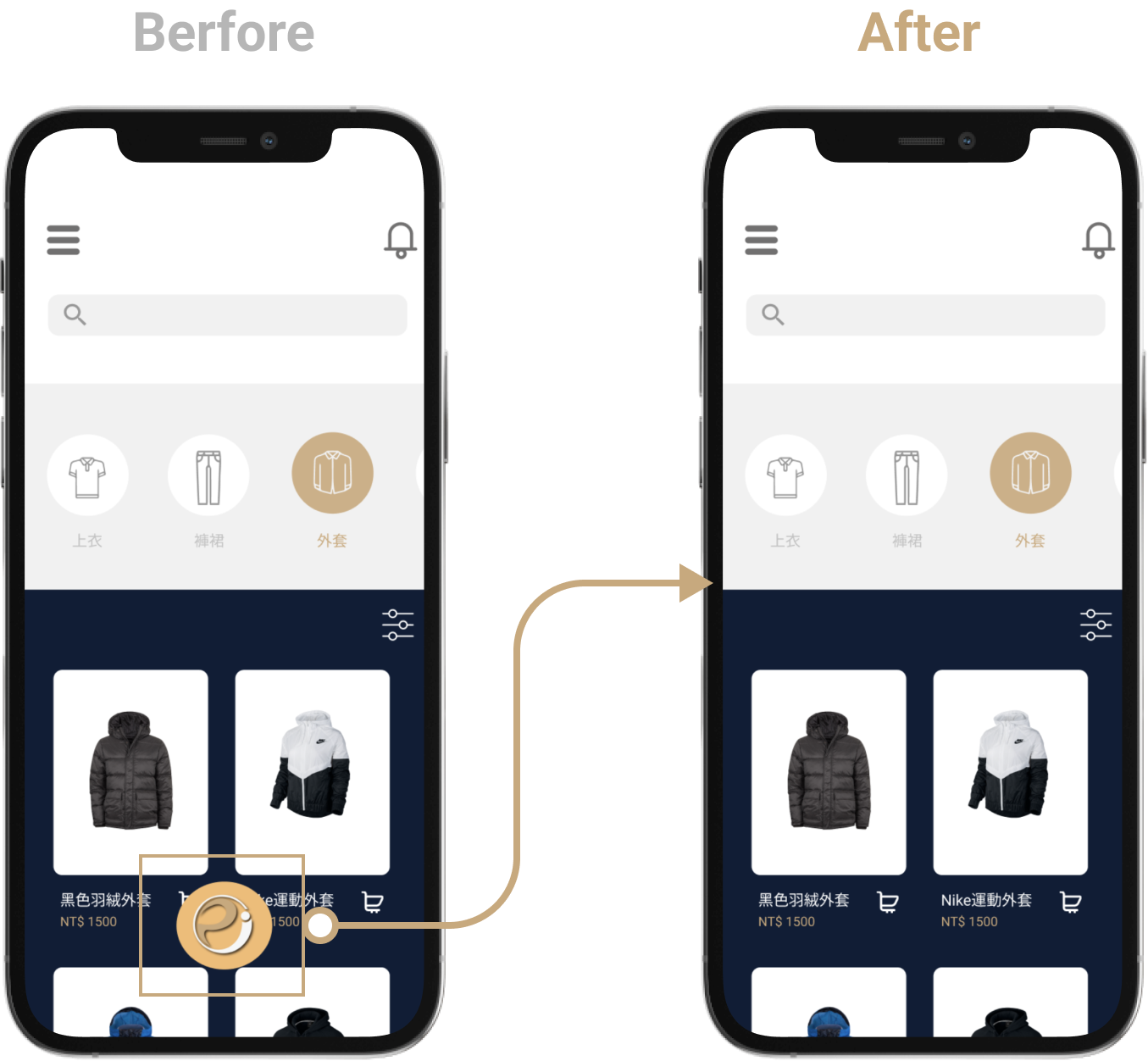Oct. 2021 - Apr. 2022 (7 months)
1 Visual Designer, 1 UX Designer, 3 Marketing, 1 Engineer
Project Management, UX Research, UX Design
Interactive Prototype, Presentation Document, Advantech Award (Merit Award)
Oct. 2021 - Apr. 2022 (7 months)
1 Visual Designer, 1 UX Designer, 3 Marketing, 1 Engineer
Project Management, UX Research, UX Design
Interactive Prototype, Presentation Document, Advantech Award (Merit Award)
Oct. 2021 - Apr. 2022 ( 7 months)
1 Visual Designer, 1 UX Designer, 3 Marketing, 1 Engineer
Project Management, UX Research, UX Design
Interactive Prototype, Presentation Document, Advantech Award (Merit Award)
Owners of high-quality clothing that no longer suits them may hesitate to sell secondhand due to low prices and a complicated selling process. Nowadays, buyers are becoming more accepting of secondhand clothing but are wary of unclear or inaccurate descriptions. Online marketplaces that prioritize transparency and quality can benefit both buyers and sellers, promoting sustainable consumption.
The goal is that existing secondhand clothing can be reactivated in the market,
achieving infinite life
and
value through circular reuse.
- Buyers can purchase high-quality clothing at lower prices than the original
retail price. By buying
unique
and distinctive clothing, they can showcase their personal style.
- Sellers can solve the problem of accumulated clothing at home and
provide sufficient incentives for
them
to
be willing to sell their clothing.
Our product has been developed through expert interviews, user research, and competitor analysis, with a focus on serving the high-quality, mid to high-priced market for secondhand apparel. Our platform offers a wide range of clothing options for both men and women, ensuring that our customers can find what they need for any occasion.

Our platform provides users with a serene and convenient environment for online shopping. We also offer detailed product descriptions, actual sizing measurements, and a rating system, ensuring that our users have a comprehensive and nuanced understanding of the condition and quality of the products they are interested in purchasing.

We offer three different processing options for secondhand apparel, allowing users to choose how they want to handle their valuable clothing. For selling, we provide a platform for secondhand clothing with a mid to high price point (above $1,500 NTD). For donation and recycling, we accept clothing of any price range.

We offer three subscription plans that provide different frequencies of clothing pickups. Users can track the status of our staff in real-time and simply pack their secondhand clothing for sale, eliminating the time and cost associated with handling the items themselves

Sustainable fashion has always been a significant issue in society,
especially with the recent promotion
of SDGs in recent years. In the clothing market, the issue of clothing waste
caused by fast fashion's
"wear and discard" mentality has been a pressing issue.
However, due to the enormous market
size of fast
fashion, it's difficult to solve the problem from the root.
Therefore, we has decided to focus on
the secondhand apparel market, partly because consumers are gradually accepting secondhand
clothing and
partly because we want to realize the value of clothing reuse.
To understand the potential user
perspective and outlook of the secondhand clothing market, we conducted 11 user interviews and 1 expert
interview.
During one of the expert interviews, we spoke with the CEO of a secondhand
trading platform to gain
insight into his observations and forecasts for the market. We received two conclusions.
- First,
secondhand markets are widely accepted in foreign countries, and there
are many related platforms and
markets.
- Second, in the Taiwan
market, the CEO observed that although
the
acceptance of secondhand
clothing in Taiwan is not as high as in other countries, there is still a
certain market for high-priced
and unique products.
During the user interview process, we conducted two phases of recruitment.In the
first phase
,
we
focused on fast fashion, sustainable fashion, and secondhand clothing
acceptance, and recruited six
participants for interviews. In the second phase, we recruited five
participants who had actual
experience purchasing secondhand clothing for interviews.
In order to obtain a comprehensive understanding of the interview data,
we conducted a two-step analysis
process. Firstly, we organized the opinions and purchasing habits of
interviewees regarding secondhand
clothing and have the following 4 key conclusions:
- Secondhand clothing with low quality
and low price is generally perceived to
have inferior quality
and
may contain more defects, making it less desirable than purchasing new clothing.
- Low-quality and low-priced secondhand
clothing typically has a more
mainstream style, which fails to
highlight individual characteristics.
- Expensive clothing that is rarely worn
is not typically purchased as
new.
- Individuals are more likely to
consider purchasing secondhand clothing that
offers high quality,
falls within the mid-to-high price range, and is priced lower than new clothing.
In the second step, we converged the research data into 3 potential user
personas, which would
assist
in identifying core product features in subsequent stages.

We conducted a competitive analysis of existing secondhand clothing trading
platforms to better understand the market ecology and identify unsatisfied
services, in order to target
the product's intended market. Through competitive analysis, we identified 2 market angles to
pursue:
- All platforms covered the high-end
market, but only one covered the
low-end clothing market.
- In terms of product offerings, all platforms only provided items for
women, with a lack of
shoes, bags,
and accessories on most platforms.

Based on the multitude of categories and price ranges in the secondhand clothing market, we needed to determine our target market and identify areas with high demand and potential. After synthesizing the results of expert interviews, two phases of user interviews, and competitor analysis, we concluded that low-priced secondhand clothing brands generally have lower quality and prices, resulting in consumers preferring to buy new clothes directly. Additionally, most platforms only offer women's clothing, and the men's market is untapped. Therefore, we decided to target the high-quality, relatively mid-to-high-priced secondhand clothing market and provide clothing for both men and women.

After identifying the target market for the product, we has convergenced
4 core product services through Point of View and How Might We statement based on the needs
of three
potential user personas:
- An integrated online secondhand trading platform.
- A graphical display of detailed and
comprehensive product
depreciation status.
- Provide Staff that Pickup the
secondhand apparel for the
user.
- Provide multiple ways to handle secondhand apparel.

After defining the core product services, we aims to design an app that provides these services. To facilitate the team visual designer's interface design, I has planned a Wireflow based on the app's functions.
There are 3 reasons why we prefers an app over a website:
- In today's era, almost everyone has a
mobile device, and an
app
enables users to enjoy platform
services
anytime and anywhere.
- Mobile phones record various aspects of our lives, making
them
feel more private and personal to us
than
a website.
- We aims to create a feeling of entering
a physical store
when
users open the app. Unlike a
website, users do not need to enter a URL or search for keywords to start browsing the shopping
platform.

Recruiting 6 participants for usability testing with a lo-fi prototype, we
aimed to answer 5 research questions:
- Is the process of buying secondhand clothes smooth to
operate?
- Is the process of listing items for sale on the platform smooth
to operate?
- Can users easily track their purchase history?
- Is the process of donating or recycling clothes smooth to
operate?
- Can users easily track the real-time status of their clothing
collection specialist?
Through the usability testing, in addition to obtaining a SUS score of
81.25 (B), which is
considered
good, we also identified 2 operational issues and made
improvements
accordingly:

In previous version, users had to click on a logo icon at the bottom of the screen to make a reservation for our services. However, usability testing showed that participants found the logo icon's purpose unclear, and it required exploration to discover its function. To address this issue, we moved the service reservation function to the Navigation drawer, making it more intuitive and accessible for users.

During the usability testing, participants found that the terms "My Products," "My Orders," and "Purchase History" were too similar in their noun definitions, which caused confusion for some users. Therefore, our team renamed "My Products" to "My Store" to focus on the products that the user has listed for sale. Additionally, we integrated "Purchase History" into "My Orders" to provide a clearer and more streamlined user experience.

This was my first time leading a team through a UX project, which gave me
a
deeper understanding and familiarity with the UX process. Looking back on the competition, from choosing
the topic to the final result, we were constantly challenged by ourselves, mentor or the judges, and the
plan
was changed and improved multiple times. But I think this is the most valuable part of the competition,
as we were not afraid to make mistakes and tried our best to learn from them through a process of trial
and error.
I am very grateful for the hard work of each team member during this period, as they spent a
lot of time brainstorming and contributing ideas despite their academic workload. I also want to express
my appreciation to our mentors who helped guide us back on track whenever we encountered difficulties,
enabling us to achieve our final results.